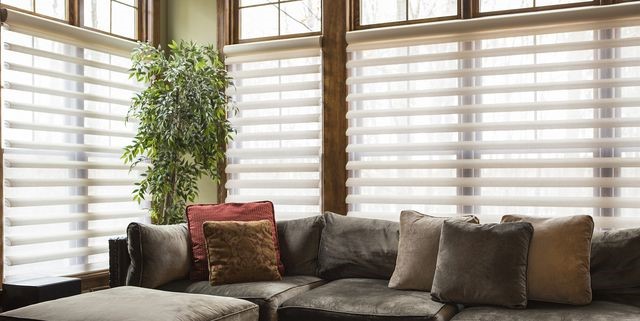
Windows form an integral part of your home design. Apart from letting in light, they provide a view of the broader world while giving you space to add a decorative edge to your interior design. Finding the ideal window blinds that tie the room together and meet your style and privacy needs can be extensive.
According to Carolyn Forté, a Good Housekeeping Institute Director, “A window is a great focal point in a room. Blinds should be both functional and decorative. We’ve come a long way from the days of hiding them behind basic mini blinds. You can now dress up a room in hundreds of ways without making a major investment.”
This blog offers detailed insights into window blinds to enable you to choose the right style that meets your purpose.
What Are Window Blinds?
Window blinds are window covers that fit on the window frame to provide privacy and control the amount of light entering a room. Blinds have tillable or adjustable slats or vanes that raise them up or down. They use mechanical or manual mechanisms to filter the amount of light entering a room.
Window blinds are available in various materials, such as fabric, wood, plastic, and metal. Blinds enhance any room’s aesthetics and are ideal for homes and offices. They are versatile, easy-to-install, clean, and functional window treatments that you can custom fit on a window of any style and size.
The 6 Benefits of Installing Window Blinds
Window blinds enhance the functionality and aesthetics of your home or office while offering greater control over your environment.
Here are the benefits of installing window blinds for your home or office:
1. Light Control
Window blinds allow one to control the amount of natural light entering the room through the window. One can adjust the slats or vanes to let in more or less light to create a comfortable and customized environment depending on your preference.
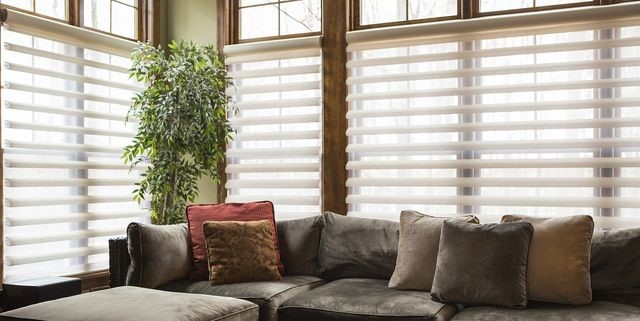
2. Privacy
Blinds can provide privacy for your home or office. You can adjust the slats or vanes to prevent outsiders from looking in, making it an excellent choice for bedrooms, bathrooms, and other private areas.
3. Energy Efficiency
Depending on the season, window blinds insulate your windows to keep your home cool or warm. Blinds such as cellular or honeycomb insulate your house while lowering the energy bills.
4. Aesthetics
Blinds are available in various styles, colours, and materials, making them ideal when adding decorative touches to your home or office.
5. Easy Maintenance
Window blinds offer an easy-to-clean, maintain, convenient, and practical window treatment.
6. Durability
Window blinds are durable, with proper care, and can last many years, making them a cost-effective investment for your home or office.
The 10 Types of Window Blinds
Window blinds come in two broad categories: vertical and horizontal blinds. Each category has different types of window blinds. When choosing blinds, it’s essential to understand your needs; each blind has unique features and benefits to complement your flooring.
Here are the different types of window blinds:
1. Wood Blinds
Wooden blinds add elegance to your spaces by incorporating nature indoors to create a warm, cosy aesthetic vibe in a room. The blinds are ideal for controlling light during the day while creating privacy. The slats are easy to tilt and have motorization options for a better outside view.
2. Aluminium Blinds
Aluminium blinds have an appealing modern aesthetic making them ideal for bedrooms and large living rooms. The blinds are made from six or eight-gauge aluminium to enhance durability.
3. Venetian Blinds
The horizontal blinds are made of aluminium, wood, or PVC. They have slats that tilt to control the amount of light and privacy. They come in various colours and sizes, making them suitable for any room.
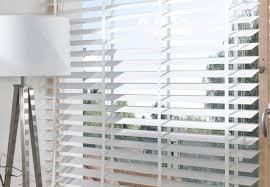
4. Roller Blinds:
These are made of a single fabric and roll up or down using a cord or chain. The blinds diffuse light to reduce brightness and guard against diminished glare and UV rays. They are ideal for bedrooms and living rooms and are available in different materials and colours.
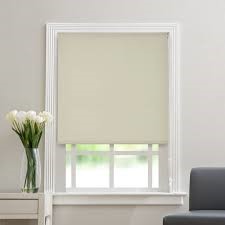
5. Vertical Blinds
These are vertical slats that rotate to control the amount of light entering the room. Vertical blinds are made of fabric or vinyl, ideal for oversized floor-to-ceiling windows or sliding glass doors overlooking a patio. They are suitable for living rooms, home theaters, and bedrooms.
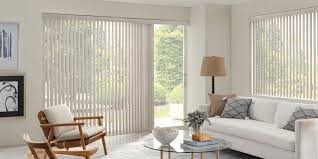
6. Panel Blinds
These are a modern take on vertical blinds and consist of large panels of fabric that slide back and forth on a track. Panel blinds are ideal for room dividers or as a cover for large windows or sliding glass doors.
7. Roman Blinds
These are made of fabric and designed to fold into pleats when raised to effortlessly add softness to a space. Roman blinds are aesthetically luxurious, making them expensive. They offer a more decorative and traditional look compared to roller blinds.
8. Cellular/Honeycomb Blinds
These unique honeycomb-like structures trap air and provide excellent insulation. Pleated blinds offer complete privacy and sound insulation, making your windows more energy efficient. Honeycomb blinds are available in different sizes and are suitable for any room.
9. Sheer Blinds
Sheer blinds are lightweight, sheer fabric that allows natural light into the room while providing some privacy. The blinds are ideal for bedrooms, living rooms, and dining rooms.
10. Pleated Blinds
Pleated blinds are made from a single piece of pleated fabric to create a neat, structured look. The blinds are available in various colours, shades, patterns, and sizes and are suitable for any room.
The 8 Factors To Consider When Buying Window Blinds
Here are factors to consider when purchasing window blinds to ensure your blinds suit your needs, taste, and preferences.
1. Purpose
Always consider why you need blinds. Is it for privacy, light control, humidity control, or decorative purposes? The end goal enables you to choose blinds that suit your needs.
2. Material
Blinds are made from various materials such as wood, fabric, aluminium, vinyl, and faux wood. Each material has unique properties, features, and benefits, touching on style, durability, and ease of cleaning. Consider your budget and preference when choosing a material; different materials attract different costs.
3. Style:
Blinds come in different styles: vertical, horizontal, cellular, roller, and roman. Different styles have unique features and benefits to meet your tastes. Opt for a style that suits your preferences and needs.
4. Size and Fit
Measure your window to ensure you get the right size of blinds that fit perfectly. Consider the depth of the window and the type of mount (inside or outside) you prefer.
5. Colour and Design
Window blinds come in different colours, shades, and designs. Choose blinds that complement your room’s décor, style, and privacy.
6. Operating System
Blinds operate manually or electronically. Manual blinds are easy to use, while electronic blinds are more convenient but attract some extra costs.
7. Price
Consider your budget when choosing blinds. Blinds come at different prices, depending on the specialty fabrics, patterns, custom sizes, features, and styles. Pick a fit that suits your budget.
8. Installation
opt for easy-to-install blinds for DIY projects and hire a professional for complex installations. Depending on the window blind type and size, some require expertise, while others are easy to install.Do you want to transform your home or office spaces with economical, durable, and easy-to-maintain window blinds? We have various unique, stylish, modern, and window treatments to suit your needs, style, and budget. Book a call today and learn about our flooring products and services. We are your tried and tested partner offering quality, durable, cost-effective custom flooring solutions in East and Central Africa.



